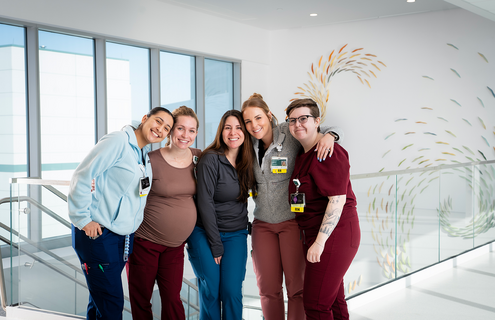
Are you confined to a bed or wheelchair, or are you helping care for someone who is?
Immobility for long periods can lead to wounds, known as pressure injuries or bed sores.
A group of nurses at Dartmouth Health have made reducing pressure injuries a priority, developing best practice guidelines so that their patients no longer have to suffer from them.
“We really wanted to figure out a way to identify the patient’s level of risk for pressure injuries and skin changes early, so that we could prevent pressure injuries from occurring, while reducing our patient’s pain, length of stay, and all the additional cost, treatment, and care that can result," says Director of Ambulatory Nursing-Surgical Specialties Meghan M. Pollard, MHCDS, BSN, RN.
The nursing team on level four of the Dartmouth Hitchcock Medical Center's west wing (known as L4WC) has gone over 290 days without a state-reportable pressure injury on their unit.
What they have learned can help patients and their caregivers outside the clinical setting, too.
Pressure injuries can happen to anyone
Pressure injuries are much more common than you might realize. They affect an estimated 2.5 million people each year, according to the National Institutes of Health.
If you're confined to a bed or a chair for a long period, you are vulnerable, as are those in intensive care units and long-term care settings.
They can not only cause pain and discomfort, but they can also lead to infection or even surgery.
Education is the first step
McKenzie L. Sauer, RN, a nurse on L4WC, says that when it comes to prevention, it is important to share best practices with the patient.
“Our patients are willing to participate when we educate,” she says.
Unit Nurse Manager Jennifer A. Mock, RN, agrees, pointing out that preventing pressure injuries is also about teamwork.
In the hospital, that means establishing and sharing best practice guidelines with the entire caregiving team.
“We came up with a team approach to give our patients the best care possible surrounding pressure injuries. Through that, we were able to drastically decrease a hospital-acquired condition and increase the quality of care we provide,” Mock says.
Avoiding pressure injuries at home
At home, the same principles apply. These are:
- Change positions regularly: Move or help your loved one change position at least every two hours to relieve pressure on the skin.
- Keep skin clean and dry: Gently clean and dry the skin, and use moisturizing creams or protective ointments as needed.
- Eat well and stay hydrated: Good nutrition and plenty of fluids help keep skin healthy and less prone to injury.
- Use supportive surfaces: Special mattresses or cushions can help distribute weight and reduce pressure on vulnerable areas.
Follow these guidelines, says the nursing team, and risks for pressure injuries significantly decrease.
Award for commitment to patients
These nurses have first-hand knowledge about the effectiveness of these prevention practices.
Not only has the L4WC unit not had a state-reportable pressure injury for over 290 days, but the group has done such a good job at preventing pressure injuries that they recently received a Nursing Excellence Award for their “Commitment to Quality.”
More Resources
Follow the O.R. journey of one patient with an infected wound